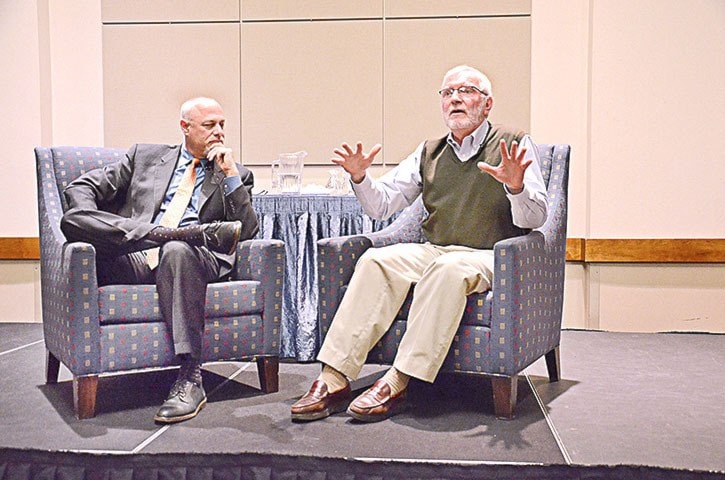What is an adult?
That occupied a great deal of discussion at the public forum Nov. 18 on the drug crisis.
The Fraser Health Authority and the social services agency Sources hosted an afternoon forum at the Coast Hotel and Convention Centre for National Addictions Awareness Week.
Much of the discussion with experts Dr. Joel Brown and Glen Grigg, a clinical therapist for more than 25 years, a professor and researcher, was focused on youth. Each demographic has very different drug issues but they say it’s vital to understand why youth use and what can be done to keep them away from drugs or get them to leave drugs behind.
Factoring into that is the delayed onset of adulthood.
People in previous generations had to start contributing to the family economics at a much younger age, whether that was rearing younger children so parents could work or going out to work themselves.
“I grew up on a farm,” Grigg explained. “I was contributing from the time I was five years old.”
Today, young people get jobs and life responsibilities later and that feeds into a sense of alienation and isolation, fed by technology.
Grigg noted that fear and anxiety levels have been studied for many years and they are higher today than in the past, yet society is generally safer.
“The probabilty of a male dying of either murder or in combat was about 15 per cent,” Grigg said of generations many years ago. “It’s now less than a third of one per cent. We’re living in a much safer world but we’re living in a much more terrifying world.”
Brown, who works in both the U.S. and Canada, drug education, treatment, evaluation and research for over 30 years.
He noted that for youth, marijuana is still the most common drug but that onset of use is a key indicator of whether they will move to harder drugs.
While they could not offer a magic pill to solve the drug crisis, they had suggestions, including letting professionals know about drug seizures and the legal system’s working in terms of the drug trade. That way the professionals have a better understanding of what’s on the streets.
The fentenyl deaths of late relate to the opiod being much more powerful than previous drugs. And carfentenil, a large animal tranquilizer much more powerful than fentenyl, has now been found in B.C.
Brown suggested that society also needs to focus on resilience to combat the drug crisis.
“The depth of the fear can become the foundation for hope,” he said.
He said resilience is a skills set and the model to use is to have users acknowledge the adversity and use it as a springboard for the future versus the just say no approach.
As an American, he’s spent years dealing with the war on drugs which he said has failed.
Drug use is nothing new but what’s changed is the prevalence and the social context.
Grigg noted that many people’s relatives a century or so ago would have used laudanum (alcohol and opium) for pain relief but there was far less addiction and abuse. He said that’s because people were “socially supported” with nuclear and extended family structures as well as being part of a community.
“People take chemicals that make them feel loved, wanted and accepted” or other substances that numb the intensity of their experience.
When people have other means that make them feel needed and contributive, they don’t turn to drugs, the two explained.
Brown noted that another factor in youth drug use is the perception of the world. Younger people tend to be uninformed about drugs, how they work in the body and potency, and don’t always trust the information from adults because so much drug education has been about scare tactics.
The message they have been getting is adults don’t want young people doing drugs and drugs are dangerous, which makes for a sometimes irresistable attraction, Grigg commented.
Brown added that youth need accurate information about drugs but also about the other factors of drug use, such as social interaction (few teens to drugs alone).
When young people have deeper social connections and a sense of who they are based on what they are interested in and interested in doing, they can then make decisions in a new context, Grigg has found in his casework. They will then ask more important questions when they consider doing drugs, such as “Do I really want to die from this?”
